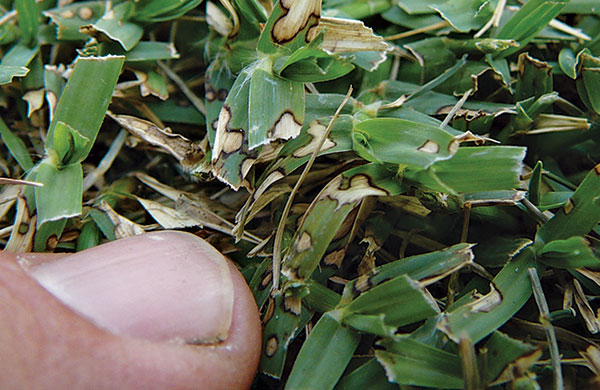Defeating dollar: Tips for controlling dollar spot

Dollar spot foliar lesions on leaf blades of bermudagrass are one of the telltale signs of dollar spot. (Photo: Bayer)
Dollar spot is a fungal disease that affects a wide variety of turfgrasses. The disease pressure of this pathogen can vary by region because its prevalence is dictated by the weather. According to Clark Throssell, Ph.D., research editor for Golfdom, dollar spot tends to severely affect turf in the Midwest. It is most prevalent in those areas from midspring to early July and flares up again in late August or early September.
“The presence of dollar spot is due to the combination of warm temperatures starting around this time of year,” Throssell says. “It’s one of those things that happens year after year on golf courses in the Midwest.” He recommends implementing a fungicide spray program early, even before signs of turf damage become apparent.
Thomas Nikolai, Ph.D., senior academic specialist at Michigan State University, says another key to controlling the dollar spot is maintaining good plant and soil microbial health.
“Research has also shown that frequent rolling can be used as a way to reduce the rate of your pesticides or maintain them at the low-label rate,” he adds. Nikolai suggests using a roller a minimum of three times per week, but not more than two times per day.
Control of dollar spot may improve as experts learn more about the disease and improve tracking technology, but in the meantime, four experts from different chemical manufacturers offer their advice for combatting the disease.

Paul Giordano
Bayer
Paul Giordano
Green Solutions Team member, Bayer Turf and Ornamental Division
The foundation of any dollar spot program is going to be the cultural practices. At the heart of that would be nutrition management, so adequate nitrogen fertility. Often, this means spoon feeding nitrogen applications throughout the summer months with at least a tenth of a pound per week. Other cultural practices would involve removing morning dew, avoiding drought stress or any moisture extremes, alleviating compaction or thatch, maximizing air movement and monitoring humidity and temperatures closely. Dollar spot is most severe when air temperatures are between 60 degrees F and 90 degrees F. In the future, on the cultural and chemical side, we’ll see things continue to go down the path of biological control methods rather than just strictly chemical control methods.

Jim Goodrich
PBI-Gordon
Jim Goodrich
Product manager, fungicides, insecticides and plant growth regulators
Dollar spot is the No. 1 disease of concern for golf course superintendents because the disease is so prevalent on high-value turf. There are many cultural practices that can be used to minimize dollar spot’s effect on playing surfaces: dew removal to reduce the leaf wetness period, adequate nitrogen fertilization and maintaining proper soil moisture. Rolling also can help reduce the incidence of dollar spot. If the pressure is high, and you are expecting it to be prolonged, there are numerous, effective fungicides for the control of the pathogen. The application of a contact fungicide and a systemic fungicide will mitigate what’s active on the surface and what’s active on the inside of the turf plants.

Nick Strain
Quali-Pro
Nick Strain
Business director, Control Solutions Inc.
Choosing your fungicide to control this pathogen can be like standing at the medicine aisle of your local Walgreens choosing an allergy medication. The advice that anyone will give is to keep it simple. What are you looking to treat? Is there a combination chemistry product that will help treat multiple diseases? Make sure to not overuse one type of chemistry. The time for early-season dollar spot treatments is also a good time to be applying chemistry to prevent other diseases. Look at fungicides that have more than one mode of action and are packaged in a single jug. This will save time and money mixing products. Another common hurdle to jump is rotating products. Look at your FRAC codes when making your spray program. If you use the same FRAC repeatedly, this will result in a resistance.

Mike Agnew
Syngenta
Mike Agnew
Technical services manager
Aside from reseeding with a turfgrass cultivar that is less susceptible to dollar spot, there are several cultural practices that can help alleviate dollar spot pressure. Three practices that can be adapted quickly are: maintaining adequate nitrogen fertility when dollar spot is active; avoiding irrigation in the late afternoon and evening because extended leaf wetness may intensify disease development; and removing dew by mowing, poling or rolling. Other cultural practices that can be added over time include: improving air circulation by selectively removing trees that prevent air movement; aerifying to alleviate soil compaction and reduce thatch; and utilizing the Smith-Kerns dollar spot prediction model to monitor favorable conditions for dollar spot. Fungicide programs should alternate between different fungicide classes, with an emphasis on the use of multisite fungicides in mixtures and rotations.












